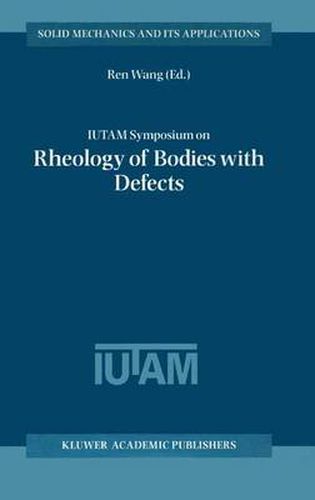Readings Newsletter
Become a Readings Member to make your shopping experience even easier.
Sign in or sign up for free!
You’re not far away from qualifying for FREE standard shipping within Australia
You’ve qualified for FREE standard shipping within Australia
The cart is loading…






This title is printed to order. This book may have been self-published. If so, we cannot guarantee the quality of the content. In the main most books will have gone through the editing process however some may not. We therefore suggest that you be aware of this before ordering this book. If in doubt check either the author or publisher’s details as we are unable to accept any returns unless they are faulty. Please contact us if you have any questions.
The IUTAM Symposium on Rheology of Bodies with Defects was held in Beijing in September, 1997. It was aimed at the development of Rheology in Solid Mechanics. Rheology is classified in Applied Mechanics Review under fluid mechanics, however, in its broadest content as was envisaged in its earlier days, it covers the whole spectrum of material behavior from elasticity, plasticity, and fluid mechanics to gas dynamics. It was thought of as a branch of continuum mechanics, but emphasized the physical aspects of different materials, and frequently proceeded from basic physical principles. As the temperature rises, the distinction between solid and fluid, and the distinction between their micro-mechanical movements, become blurred. The physical description of such materials and their movements must be based on the thermodynamic principles of state variable theory; the classical division between solid and fluid mechanics disappears. Under the classification adopted by Applied Mechanics Reviews, the subjects dealt with in this symposium come closer to viscoelasticity and viscoplasticity, especially close to the subdivision of creep dealing with creep rupture. The symposium focused at building a bridge between macroscopic and microscopic research on damage and fracture behavior of defective bodies made of metal, polymer, composite and other viscoelastic materials. Two different approaches are presented at the symposium. The first is a continuum damage theory for time-dependent evolution of defects at the macro/meso/microscopic levels.
$9.00 standard shipping within Australia
FREE standard shipping within Australia for orders over $100.00
Express & International shipping calculated at checkout
This title is printed to order. This book may have been self-published. If so, we cannot guarantee the quality of the content. In the main most books will have gone through the editing process however some may not. We therefore suggest that you be aware of this before ordering this book. If in doubt check either the author or publisher’s details as we are unable to accept any returns unless they are faulty. Please contact us if you have any questions.
The IUTAM Symposium on Rheology of Bodies with Defects was held in Beijing in September, 1997. It was aimed at the development of Rheology in Solid Mechanics. Rheology is classified in Applied Mechanics Review under fluid mechanics, however, in its broadest content as was envisaged in its earlier days, it covers the whole spectrum of material behavior from elasticity, plasticity, and fluid mechanics to gas dynamics. It was thought of as a branch of continuum mechanics, but emphasized the physical aspects of different materials, and frequently proceeded from basic physical principles. As the temperature rises, the distinction between solid and fluid, and the distinction between their micro-mechanical movements, become blurred. The physical description of such materials and their movements must be based on the thermodynamic principles of state variable theory; the classical division between solid and fluid mechanics disappears. Under the classification adopted by Applied Mechanics Reviews, the subjects dealt with in this symposium come closer to viscoelasticity and viscoplasticity, especially close to the subdivision of creep dealing with creep rupture. The symposium focused at building a bridge between macroscopic and microscopic research on damage and fracture behavior of defective bodies made of metal, polymer, composite and other viscoelastic materials. Two different approaches are presented at the symposium. The first is a continuum damage theory for time-dependent evolution of defects at the macro/meso/microscopic levels.